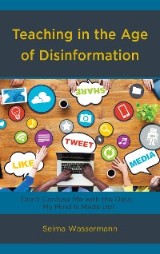Details

Teaching in the Age of Disinformation
Don't Confuse Me with the Data, My Mind Is Made Up!|
34,99 € |
|
| Verlag: | Rowman & Littlefield Publishers |
| Format: | EPUB |
| Veröffentl.: | 04.05.2018 |
| ISBN/EAN: | 9781475840995 |
| Sprache: | englisch |
| Anzahl Seiten: | 184 |
DRM-geschütztes eBook, Sie benötigen z.B. Adobe Digital Editions und eine Adobe ID zum Lesen.
Beschreibungen
<span><span>Teaching in the Age of Disinformation</span><span> makes a case for the importance of developing students’ intelligent habits of mind so that they become more discriminating consumers of the information that comes at them from the Internet, social media, television and the tabloid press in this “alternate truth” era. Part I sets the stage for the need for an informed citizenry, given the many and varied sources of disinformation that they are exposed to and what the implications are when they are unable to make such distinctions. Part II deals with the specifics of how teachers may develop curriculum activities that call for higher order thinking, within the many and diverse subject areas of elementary and secondary education. Hundreds of examples of curriculum activities are included, as well as suggestions for how teachers use higher order questioning strategies in classroom discussions to enable and promote student thinking. “A pleasure to read,” the book draws on the author’s long and extensive experience in teaching, writing and research with “teaching for thinking,” and offers teachers research-tested ways to incorporate the development of students’ intelligent habits of mind in their daily classroom work.</span></span>
<span><span>This book gives teachers the tools and the teaching strategies to enable their students to become more discriminating consumers of information and misinformation coming at them from the Internet, social media, television and the tabloid press. It is an essential resource, rich in practical suggestions for classroom activities for every grade level.</span></span>
<span><span>Preface</span></span>
<br>
<span><span>Acknowledgements</span></span>
<br>
<span><span>Introduction</span></span>
<br>
<span><span>Section 1</span></span>
<br>
<span><span>Chapter 1- What Can Teachers Do?</span></span>
<br>
<span><span>Chapter 2- Shifting Gears in the Curriculum to Emphasize Teaching for Thinking: An Overview</span></span>
<br>
<span><span>A Teaching for Thinking Curriculum Framework</span></span>
<br>
<span><span>To Know, To Understand, and To Know How – Key Steps in Teaching for Thinking</span></span>
<br>
<span><span>An Instructional Design for Teaching for Thinking</span></span>
<br>
<span><span>Chapter 3- Guidelines for Beginning a Teaching for Thinking Program</span></span>
<br>
<span><span>Section 2</span></span>
<br>
<span><span>Chapter 4- Introduction to Observing</span></span>
<br>
<span><span>Classroom Applications</span></span>
<br>
<span><span>Chapter 5- Introduction to Comparing</span></span>
<br>
<span><span>Classroom Applications</span></span>
<br>
<span><span>Chapter 6- Introduction to Classifying</span></span>
<br>
<span><span>Classroom Applications</span></span>
<br>
<span><span>Chapter 7- Introduction to Suggesting Hypotheses</span></span>
<br>
<span><span>Classroom Applications</span></span>
<br>
<span><span>Chapter 8- Introduction to Searching Out Assumptions</span></span>
<br>
<span><span>Classroom Applications</span></span>
<br>
<span><span>Chapter 9- Introduction to Summarizing</span></span>
<br>
<span><span>Classroom Applications</span></span>
<br>
<span><span>Chapter 10- Introduction to Interpreting </span></span>
<br>
<span><span>Classroom Applications</span></span>
<br>
<span><span>Chapter 11- Introduction to Making Decisions</span></span>
<br>
<span><span>Classroom Applications</span></span>
<br>
<span><span>Chapter 12- Introduction to Designing Projects and Investigations</span></span>
<br>
<span><span>Classroom Applications</span></span>
<br>
<span><span>Chapter 13- Introduction to Creating and Inventing</span></span>
<br>
<span><span>Classroom Applications</span></span>
<br>
<span><span>Chapter 14- Introduction to Evaluating and Assessing</span></span>
<br>
<span><span>Classroom Applications</span></span>
<br>
<span><span>Section 3</span></span>
<br>
<span><span>Chapter 15- Dealing With Students’ Deeply Held Beliefs</span></span>
<br>
<span><span>Classroom Applications</span></span>
<br>
<span><span>Chapter 16- Using Questions and Responses that Promote Further Examination of Issues: The Interactive Dialogue</span></span>
<br>
<span><span>Chapter 17- Evaluating Students’ Work</span></span>
<br>
<span><span>But Is It Working?</span></span>
<br>
<span><span>Using Self-Assessments</span></span>
<br>
<span><span>Profiles of Student Behaviors</span></span>
<br>
<span><span>Chapter 18- The Teacher is the Key</span></span>
<br>
<span><span>Bibliography<br>About the Author</span></span>
<br>
<span></span>
<br>
<span><span>Acknowledgements</span></span>
<br>
<span><span>Introduction</span></span>
<br>
<span><span>Section 1</span></span>
<br>
<span><span>Chapter 1- What Can Teachers Do?</span></span>
<br>
<span><span>Chapter 2- Shifting Gears in the Curriculum to Emphasize Teaching for Thinking: An Overview</span></span>
<br>
<span><span>A Teaching for Thinking Curriculum Framework</span></span>
<br>
<span><span>To Know, To Understand, and To Know How – Key Steps in Teaching for Thinking</span></span>
<br>
<span><span>An Instructional Design for Teaching for Thinking</span></span>
<br>
<span><span>Chapter 3- Guidelines for Beginning a Teaching for Thinking Program</span></span>
<br>
<span><span>Section 2</span></span>
<br>
<span><span>Chapter 4- Introduction to Observing</span></span>
<br>
<span><span>Classroom Applications</span></span>
<br>
<span><span>Chapter 5- Introduction to Comparing</span></span>
<br>
<span><span>Classroom Applications</span></span>
<br>
<span><span>Chapter 6- Introduction to Classifying</span></span>
<br>
<span><span>Classroom Applications</span></span>
<br>
<span><span>Chapter 7- Introduction to Suggesting Hypotheses</span></span>
<br>
<span><span>Classroom Applications</span></span>
<br>
<span><span>Chapter 8- Introduction to Searching Out Assumptions</span></span>
<br>
<span><span>Classroom Applications</span></span>
<br>
<span><span>Chapter 9- Introduction to Summarizing</span></span>
<br>
<span><span>Classroom Applications</span></span>
<br>
<span><span>Chapter 10- Introduction to Interpreting </span></span>
<br>
<span><span>Classroom Applications</span></span>
<br>
<span><span>Chapter 11- Introduction to Making Decisions</span></span>
<br>
<span><span>Classroom Applications</span></span>
<br>
<span><span>Chapter 12- Introduction to Designing Projects and Investigations</span></span>
<br>
<span><span>Classroom Applications</span></span>
<br>
<span><span>Chapter 13- Introduction to Creating and Inventing</span></span>
<br>
<span><span>Classroom Applications</span></span>
<br>
<span><span>Chapter 14- Introduction to Evaluating and Assessing</span></span>
<br>
<span><span>Classroom Applications</span></span>
<br>
<span><span>Section 3</span></span>
<br>
<span><span>Chapter 15- Dealing With Students’ Deeply Held Beliefs</span></span>
<br>
<span><span>Classroom Applications</span></span>
<br>
<span><span>Chapter 16- Using Questions and Responses that Promote Further Examination of Issues: The Interactive Dialogue</span></span>
<br>
<span><span>Chapter 17- Evaluating Students’ Work</span></span>
<br>
<span><span>But Is It Working?</span></span>
<br>
<span><span>Using Self-Assessments</span></span>
<br>
<span><span>Profiles of Student Behaviors</span></span>
<br>
<span><span>Chapter 18- The Teacher is the Key</span></span>
<br>
<span><span>Bibliography<br>About the Author</span></span>
<br>
<span></span>
<span><span>Selma Wassermann</span><span> is Professor Emerita in the Faculty of Education at Simon Fraser University. Her books include </span><span>Teaching for Thinking Today: Theory, Strategies and Activities for the K-8 Classroom</span><span>, </span><span>This Teaching Life</span><span>, </span><span>The Art of Interactive Teaching</span><span>,</span><span> </span><span>and </span><span>An Introduction to Case Method Teaching: A Guide to the Galaxy</span><span>.</span><span> </span></span>


















